Miniaturized Wideband Antenna Prototype Operating over the Ku-Band
Abstract
:1. Introduction
2. Design of the Unit Cell
2.1. Generation of the Proposed Prototype
- Step 1: Start;
- Step 2: Note the phase values above the feed waveguide source at 3 mm above it;
- Step 3: Place the respective cuboids noted from the database of the transmission coefficient magnitude and phase values across the aperture positions;
- Step 4: Check the corrected phase near the top surface of the proposed prototype at 0.125;
- Step 5: Is the corrected phase value less than in the designed frequency?
- If No, change the cuboids’ lateral dimensions, and again, place them in the defined aperture positions. Go to Step 4;
- If Yes, place the respective cuboids in the defined aperture positions of 3.75 mm, 11.25 mm, 18.75 mm, and 26.25 mm from the center position. This will generate the proposed prototype;
- Step 6: End.
2.2. Phase Distribution of the Proposed Prototype
3. Results and Discussion
3.1. Details of the Fabrication and Measurement
3.2. Radiation Plots
3.3. Plots of the Properties
4. Conclusions
Author Contributions
Funding
Acknowledgments
Conflicts of Interest
References
- Balanis, C.A. Antenna Theory: Analysis and Design; John Wiley & Sons: Hoboken, NJ, USA, 2015. [Google Scholar]
- Fernandes, C.A.; Lima, E.B.; Costa, J.R. Dielectric lens antennas. In Handbook of Antenna Technologies; Springer: Berlin/Heidelberg, Germany, 2016; pp. 1001–1064. [Google Scholar]
- Dahri, M.H.; Jamaluddin, M.H.; Abbasi, M.I.; Kamarudin, M.R. A review of wideband reflectarray antennas for 5G communication systems. IEEE Access 2017, 5, 17803–17815. [Google Scholar] [CrossRef]
- Nayeri, P.; Liang, M.; Sabory-Garcı, R.A.; Tuo, M.; Yang, F.; Gehm, M.; Xin, H.; Elsherbeni, A.Z. 3D printed dielectric reflectarrays: Low-cost high-gain antennas at sub-millimeter waves. IEEE Trans. Antennas Propag. 2014, 62, 2000–2008. [Google Scholar] [CrossRef]
- Fazaelifar, M.; Jam, S.; Basiri, R. Design and fabrication of a wideband reflectarray antenna in Ku and K bands. AEU Int. J. Electron. Commun. 2018, 95, 304–312. [Google Scholar] [CrossRef]
- Massaccesi, A.; Pirinoli, P.; Bertana, V.; Scordo, G.; Marasso, S.L.; Cocuzza, M.; Dassano, G. 3D-printable dielectric transmitarray with enhanced bandwidth at millimeter-waves. IEEE Access 2018, 6, 46407–46418. [Google Scholar] [CrossRef]
- Li, M.Y.; Ban, Y.L.; Yan, F.Q. Wideband Low-Profile Ku-Band Transmitarray Antenna. IEEE Access 2020, 9, 6683–6688. [Google Scholar] [CrossRef]
- Hashmi, R.M.; Zeb, B.A.; Esselle, K.P. Wideband high-gain EBG resonator antennas with small footprints and all-dielectric superstructures. IEEE Trans. Antennas Propag. 2014, 62, 2970–2977. [Google Scholar] [CrossRef]
- Yu, Y.H.; Zong, Z.Y.; Wu, W.; Fang, D.G. Dielectric slab superstrate electrically small antennas with high gain and wideband. IEEE Antennas Wirel. Propag. Lett. 2020, 19, 1476–1480. [Google Scholar] [CrossRef]
- Wang, N.; Talbi, L.; Zeng, Q.; Xu, J. Wideband Fabry-Perot resonator antenna with electrically thin dielectric superstrates. IEEE Access 2018, 6, 14966–14973. [Google Scholar] [CrossRef]
- Hashmi, R.M.; Esselle, K.P. A class of extremely wideband resonant cavity antennas with large directivity-bandwidth products. IEEE Trans. Antennas Propag. 2015, 64, 830–835. [Google Scholar] [CrossRef]
- Baba, A.A.; Hashmi, R.M.; Esselle, K.P.; Weily, A.R. Compact high-gain antenna with simple all-dielectric partially reflecting surface. IEEE Trans. Antennas Propag. 2018, 66, 4343–4348. [Google Scholar] [CrossRef]
- Lalbakhsh, A.; Afzal, M.U.; Esselle, K.P.; Smith, S.L.; Zeb, B.A. Single-dielectric wideband partially reflecting surface with variable reflection components for realization of a compact high-gain resonant cavity antenna. IEEE Trans. Antennas Propag. 2019, 67, 1916–1921. [Google Scholar] [CrossRef]
- Zhou, L.; Luo, Z.; Zhou, Y.; Chen, X. High Directivity Fabry–Perot Antenna With a Nonuniform Partially Reflective Surface and a Phase Correcting Structure. IEEE Trans. Antennas Propag. 2020, 68, 7601–7606. [Google Scholar] [CrossRef]
- Cao, W.; Lv, X.; Wang, Q.; Zhao, Y.; Yang, X. Wideband circularly polarized Fabry–Pérot resonator antenna in Ku-band. IEEE Antennas Wirel. Propag. Lett. 2019, 18, 586–590. [Google Scholar] [CrossRef]
- Meng, F.; Sharma, S.K. A wideband resonant cavity antenna with compact partially reflective surface. IEEE Trans. Antennas Propag. 2019, 68, 1155–1160. [Google Scholar] [CrossRef]
- Wang, N.; Liu, Q.; Wu, C.; Talbi, L.; Zeng, Q.; Xu, J. Wideband Fabry-Perot resonator antenna with two complementary FSS layers. IEEE Trans. Antennas Propag. 2014, 62, 2463–2471. [Google Scholar]
- Kanjanasit, K.; Wang, C. A wideband resonant cavity antenna assembled using a micromachined CPW-fed patch source and a two-layer metamaterial superstrate. IEEE Trans. Compon. Packag. Manuf. Technol. 2018, 9, 1142–1150. [Google Scholar] [CrossRef]
- Abdulkarim, Y.I.; Awl, H.N.; Muhammadsharif, F.F.; Karaaslan, M.; Mahmud, R.H.; Hasan, S.O.; Işık, Ö.; Luo, H.; Huang, S. A low-profile antenna based on single-layer metasurface for Ku-band applications. Int. J. Antennas Propag. 2020, 2020, 8813951. [Google Scholar] [CrossRef]
- Alkaraki, S.; Gao, Y.; Stremsdoerfer, S.; Gayets, E.; Parini, C.G. 3D printed corrugated plate antennas with high aperture efficiency and high gain at X-band and Ka-band. IEEE Access 2020, 8, 30643–30654. [Google Scholar] [CrossRef]
- Asci, Y.; Yegin, K. Three-dimensional printed wideband, dual-cavity Ku-band antenna. Int. J. Microw. Comput.-Aided Eng. 2020, 30, e22071. [Google Scholar] [CrossRef]
- Chen, Q.; Chen, X.; Xu, K. 3-D printed Fabry–Perot resonator antenna with paraboloid-shape superstrate for wide gain bandwidth. Appl. Sci. 2017, 7, 1134. [Google Scholar] [CrossRef] [Green Version]
- Hayat, T.; Afzal, M.U.; Ahmed, F.; Zhang, S.; Esselle, K.P.; Vardaxoglou, Y. Low-cost ultrawideband high-gain compact resonant cavity antenna. IEEE Antennas Wirel. Propag. Lett. 2020, 19, 1271–1275. [Google Scholar] [CrossRef]
- Ponti, C.; Baccarelli, P.; Ceccuzzi, S.; Schettini, G. Tapered All-Dielectric EBGs With 3-D Additive Manufacturing for High-Gain Resonant-Cavity Antennas. IEEE Trans. Antennas Propag. 2020, 69, 2473–2480. [Google Scholar] [CrossRef]
- Shrestha, S.; Zahra, H.; Abbasi, M.A.B.; Asadnia, M.; Abbas, S.M. Increasing the directivity of resonant cavity antennas with nearfield transformation meta-structure realized with stereolithograpy. Electronics 2021, 10, 333. [Google Scholar] [CrossRef]
- Shrestha, S.; Baba, A.A.; Abbas, S.M.; Asadnia, M.; Hashmi, R.M. A horn antenna covered with a 3D-printed metasurface for gain enhancement. Electronics 2021, 10, 119. [Google Scholar] [CrossRef]
- Shrestha, S.; Zahra, H.; Abbas, S.M.; Kiyani, A.; Mohamadzade, B.; Asadnia, M. Generation of Beam Tilt through Three-Dimensional Printed Surface. Electronics 2021, 10, 3174. [Google Scholar] [CrossRef]
- Shrestha, S.; Choi, D.Y. Rain attenuation over terrestrial microwave links in South Korea. IET Microw. Antennas Propag. 2017, 11, 1031–1039. [Google Scholar] [CrossRef]
- Shrestha, S.; Choi, D.Y. Study of 1-min rain rate integration statistic in South Korea. J. Atmos. Sol.-Terr. Phys. 2017, 155, 1–11. [Google Scholar] [CrossRef]
- Shrestha, S.; Choi, D.Y. Rain Attenuation Study at Ku-Band over Earth-Space Path in South Korea. Adv. Astron. 2019, 2019, 9538061. [Google Scholar] [CrossRef]
- CST Software. CST Microwave Studio, CST Studio Suite-2019, Computer Simulation Technology AG. CST Microwave Studio User Manual. CST. 2019. Available online: http://www.cst.com/products/cstmws (accessed on 1 March 2022).
- Goulas, A.; Zhang, S.; Cadman, D.A.; Järveläinen, J.; Mylläri, V.; Whittow, W.G.; Vardaxoglou, J.Y.C.; Engstrøm, D.S. The impact of 3D printing process parameters on the dielectric properties of high permittivity composites. Designs 2019, 3, 50. [Google Scholar] [CrossRef] [Green Version]
- Preperm. Available online: https://www.preperm.com/webshop/product/preperm-3d-abs-%c9%9br-10-0-filament-1-75mm/ (accessed on 1 March 2022).

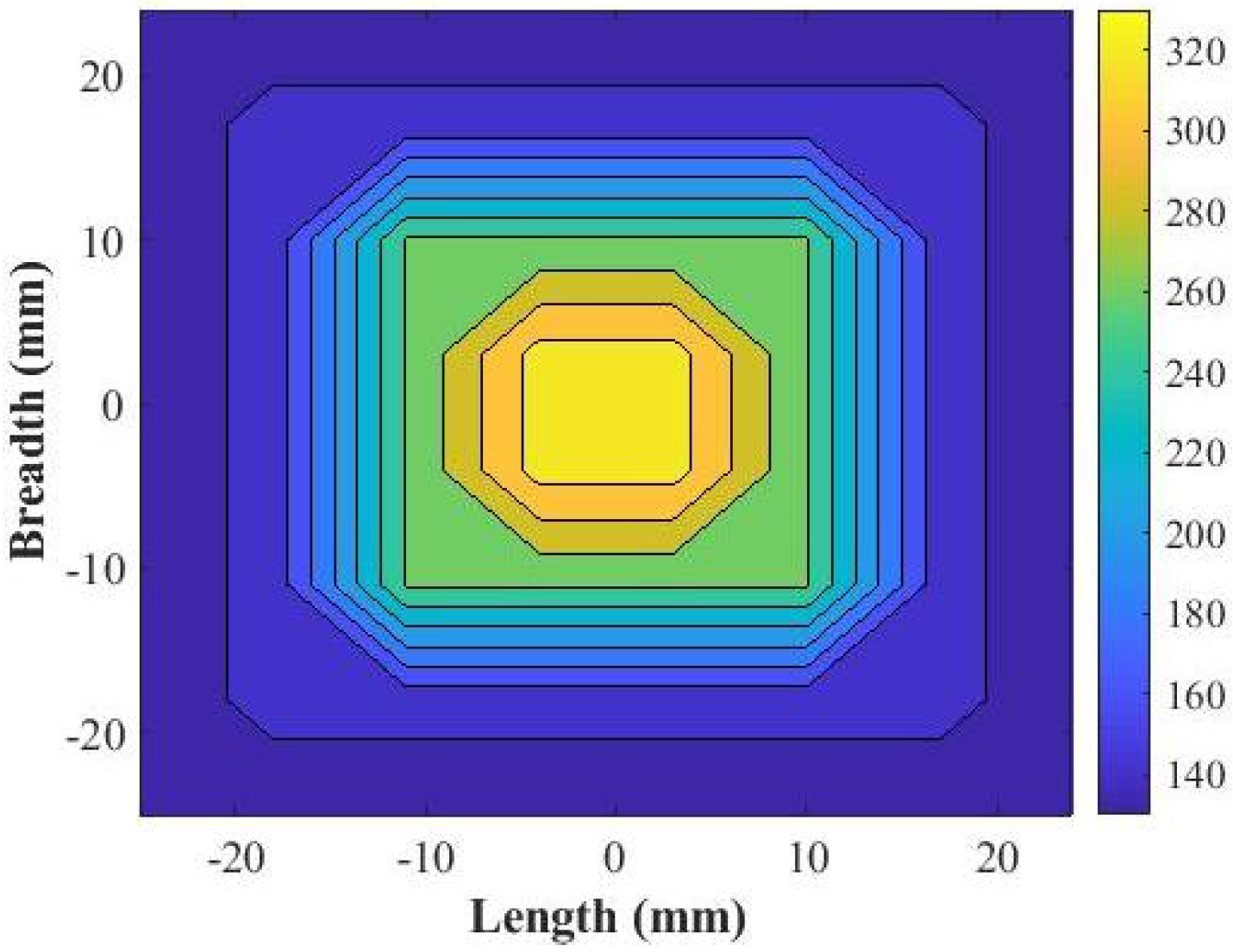
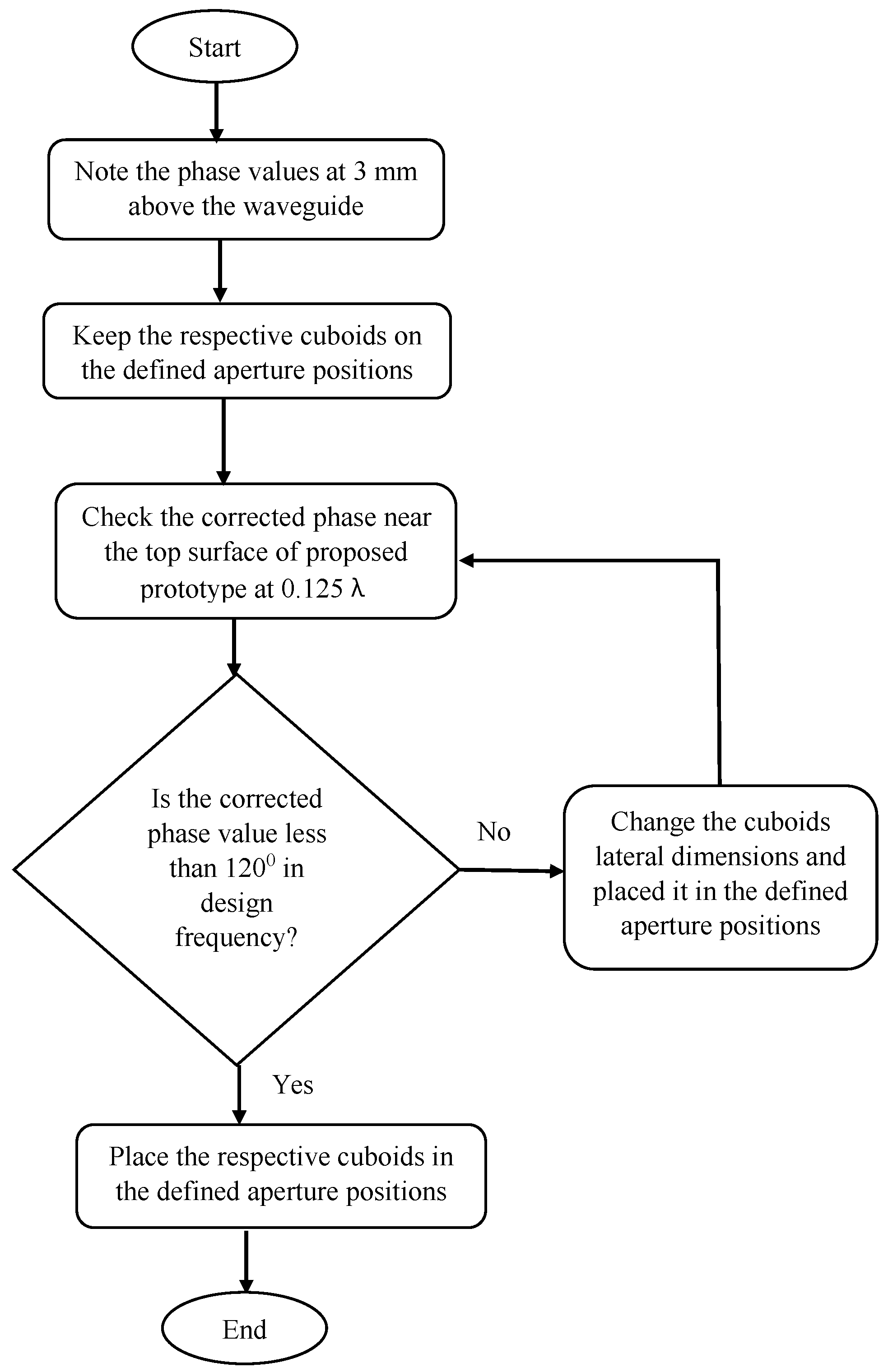

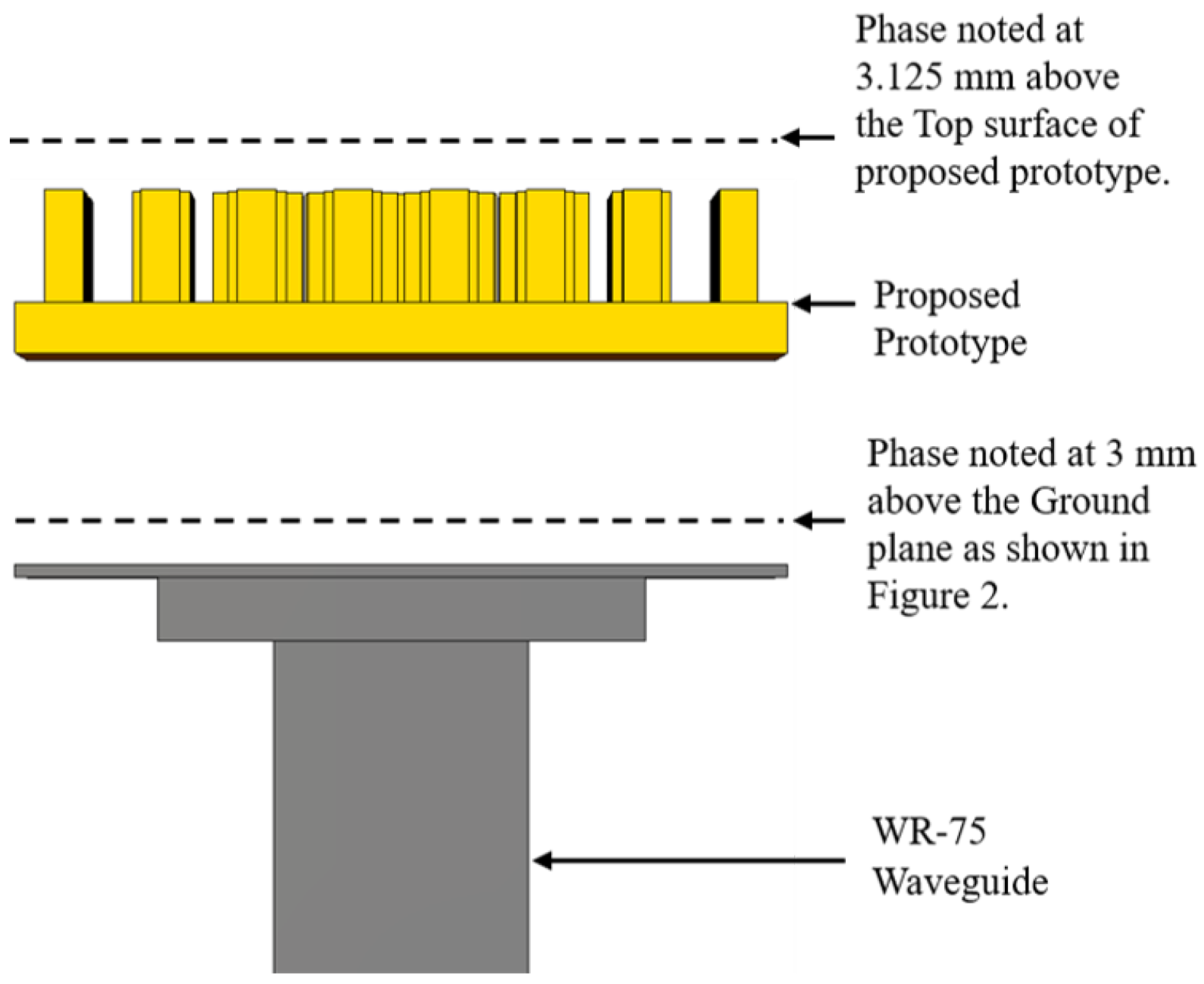
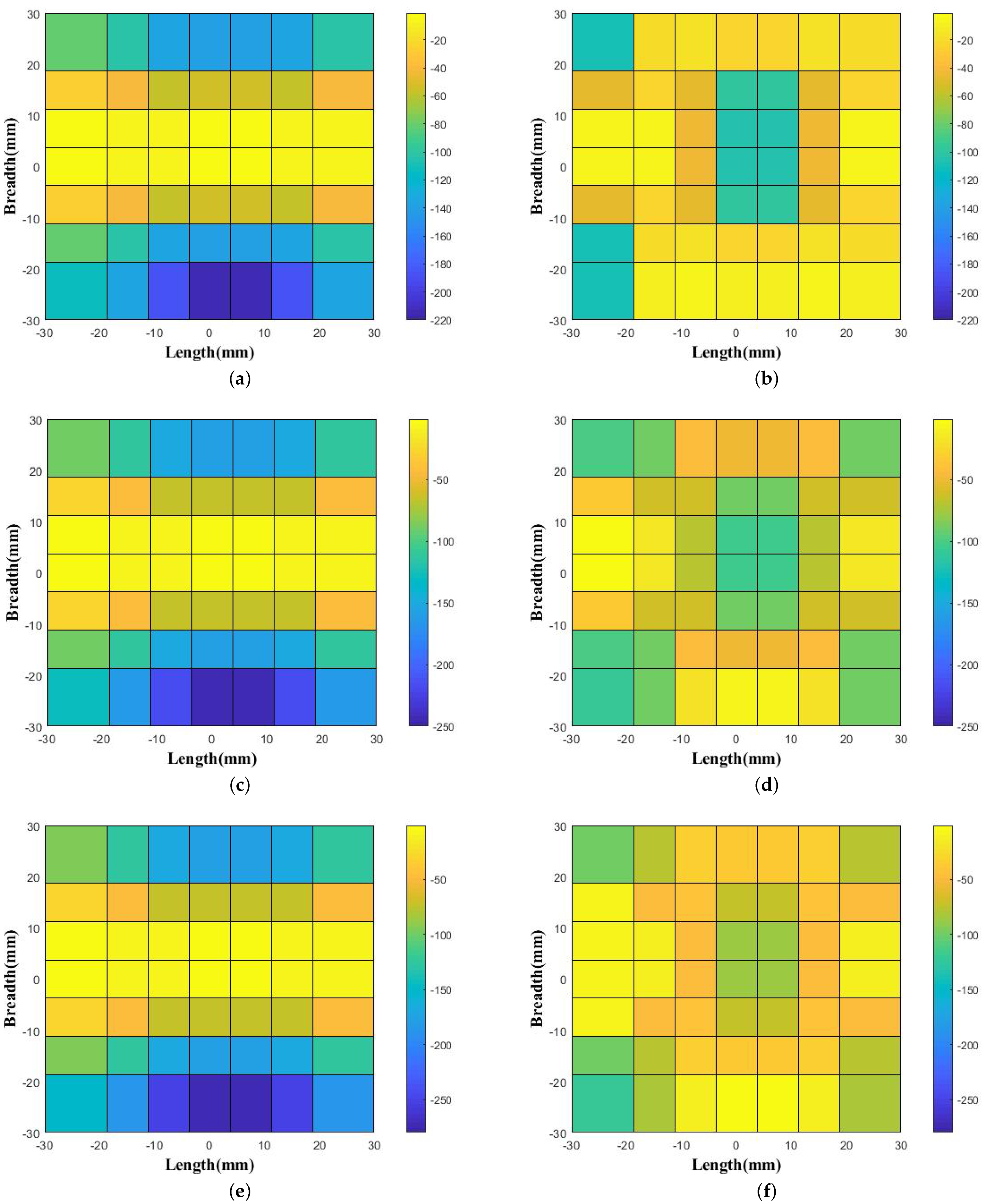
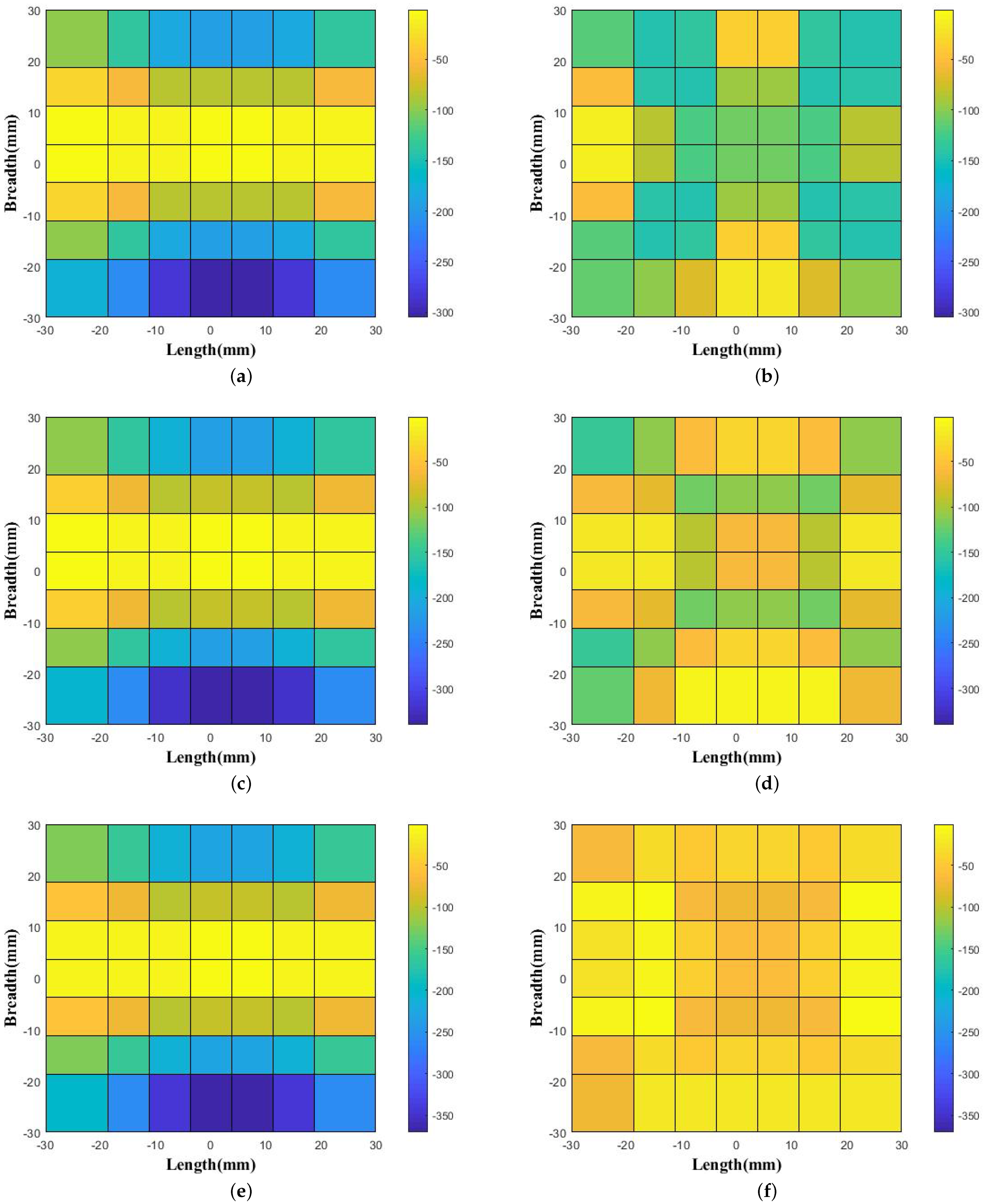
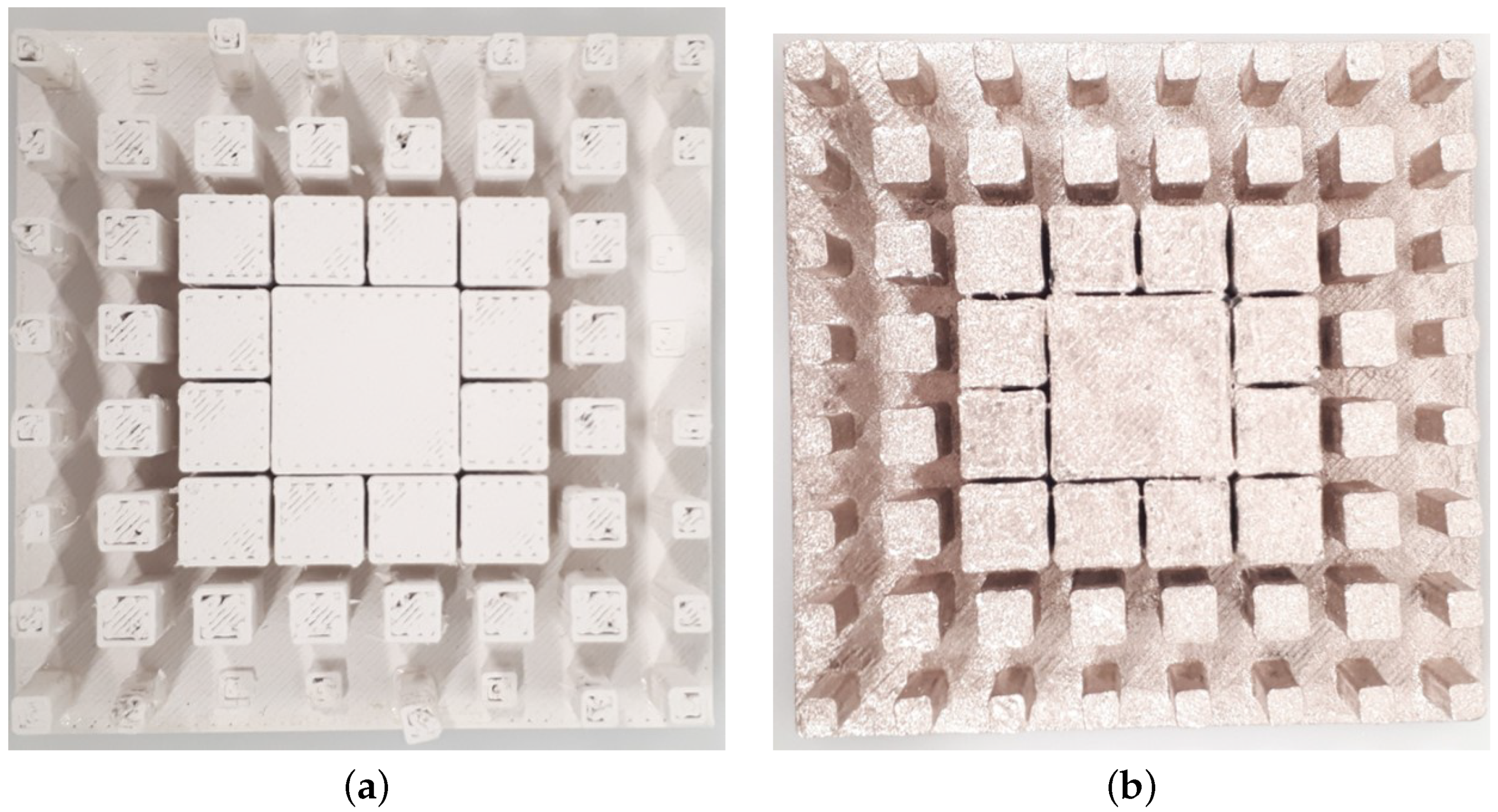
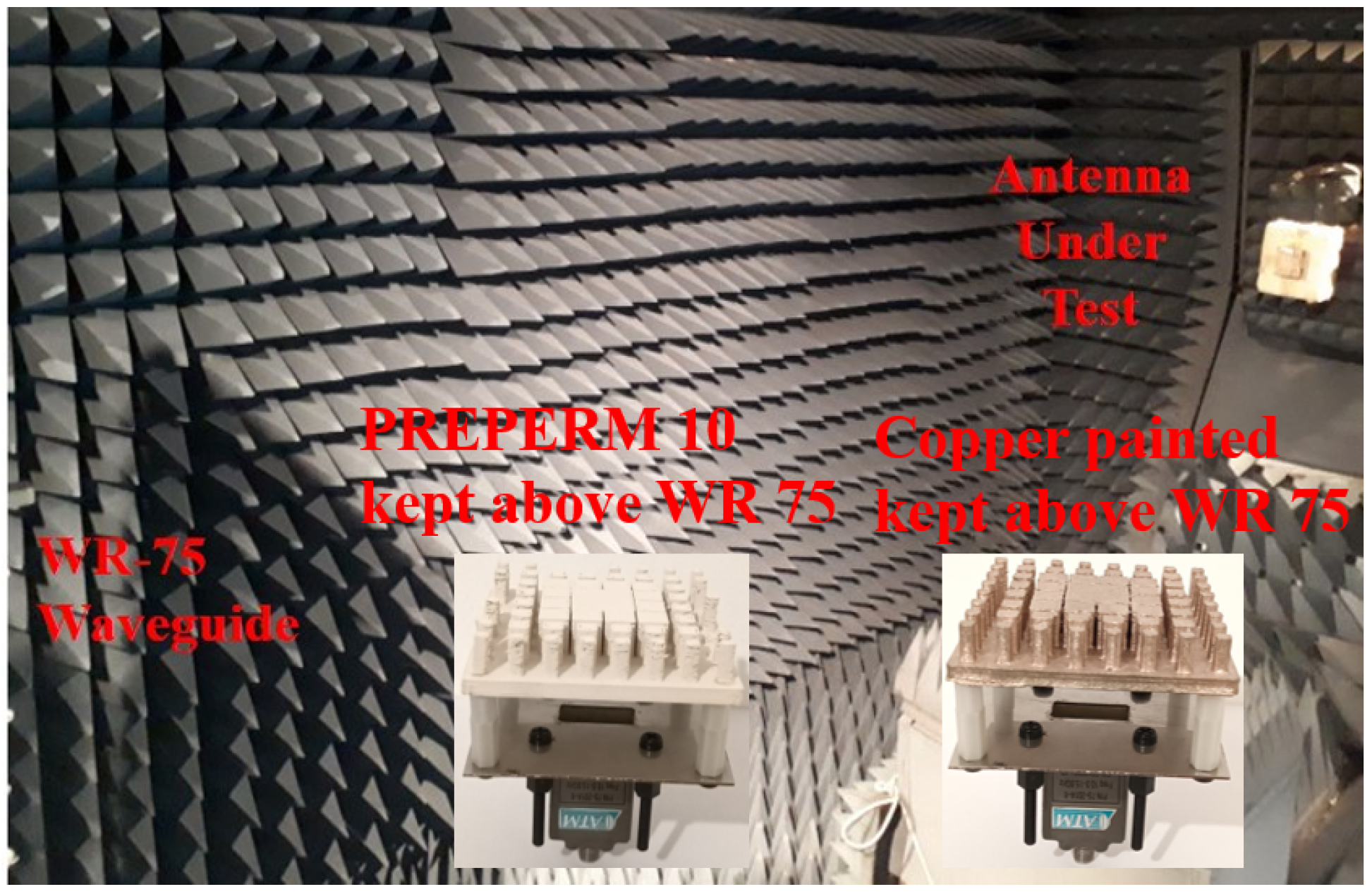
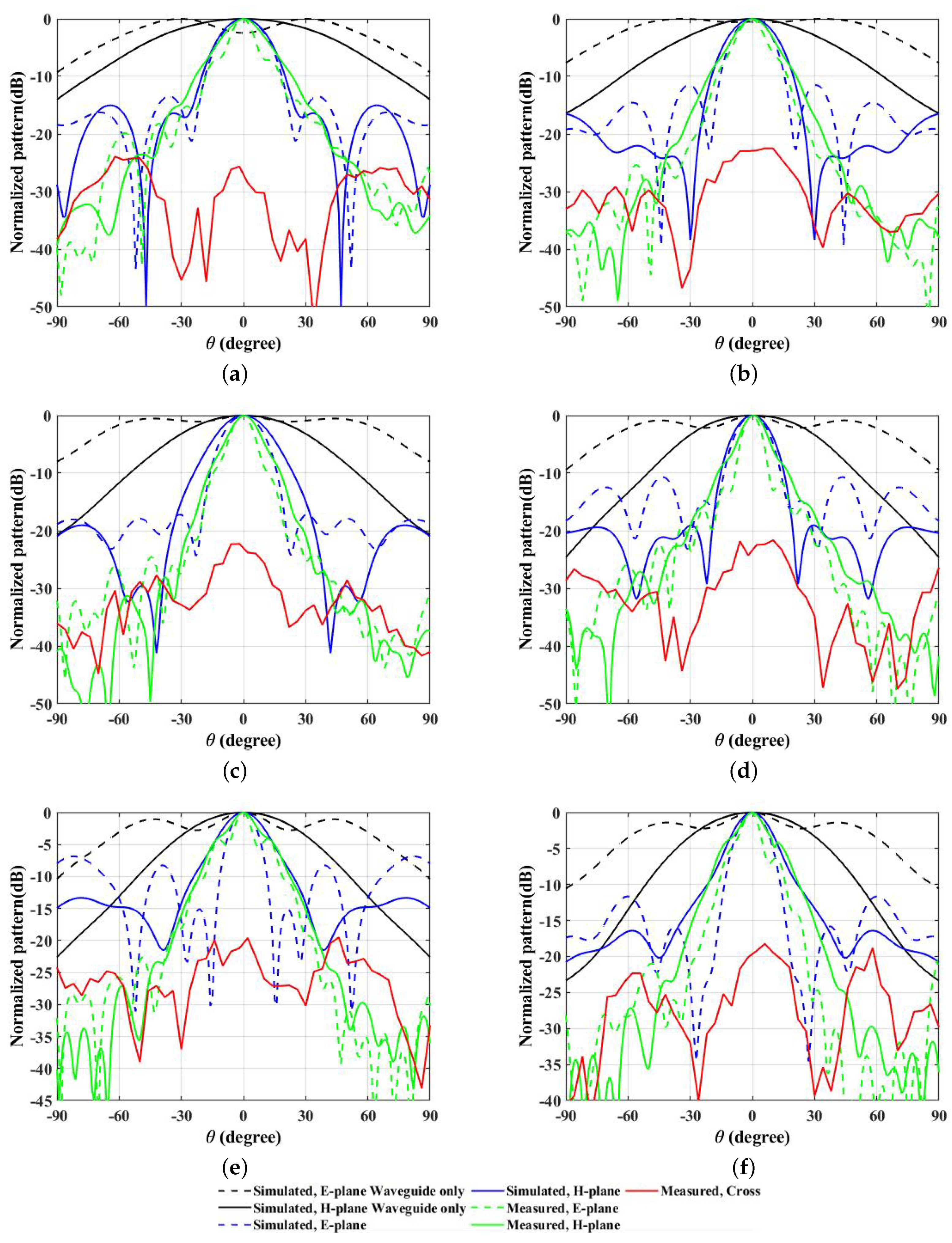
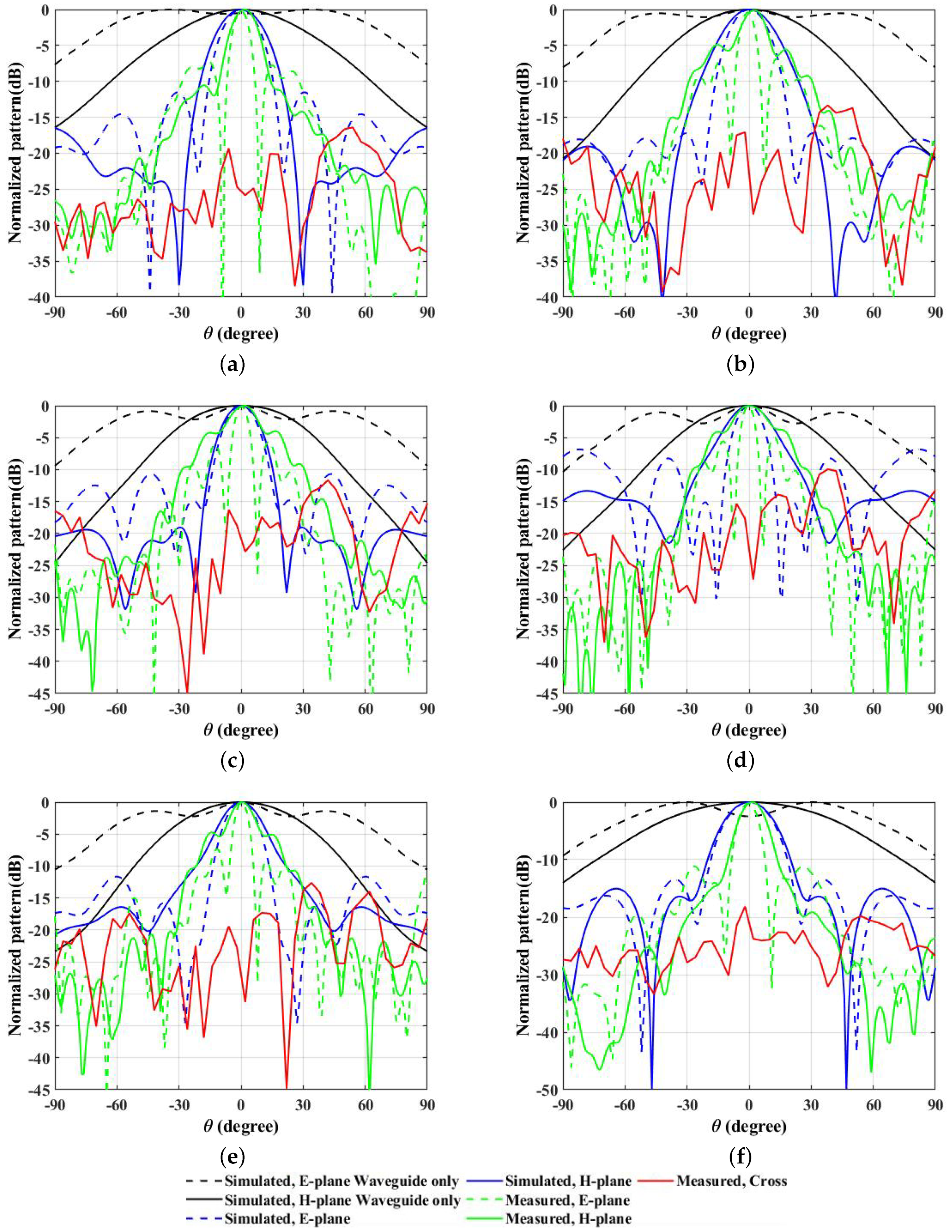

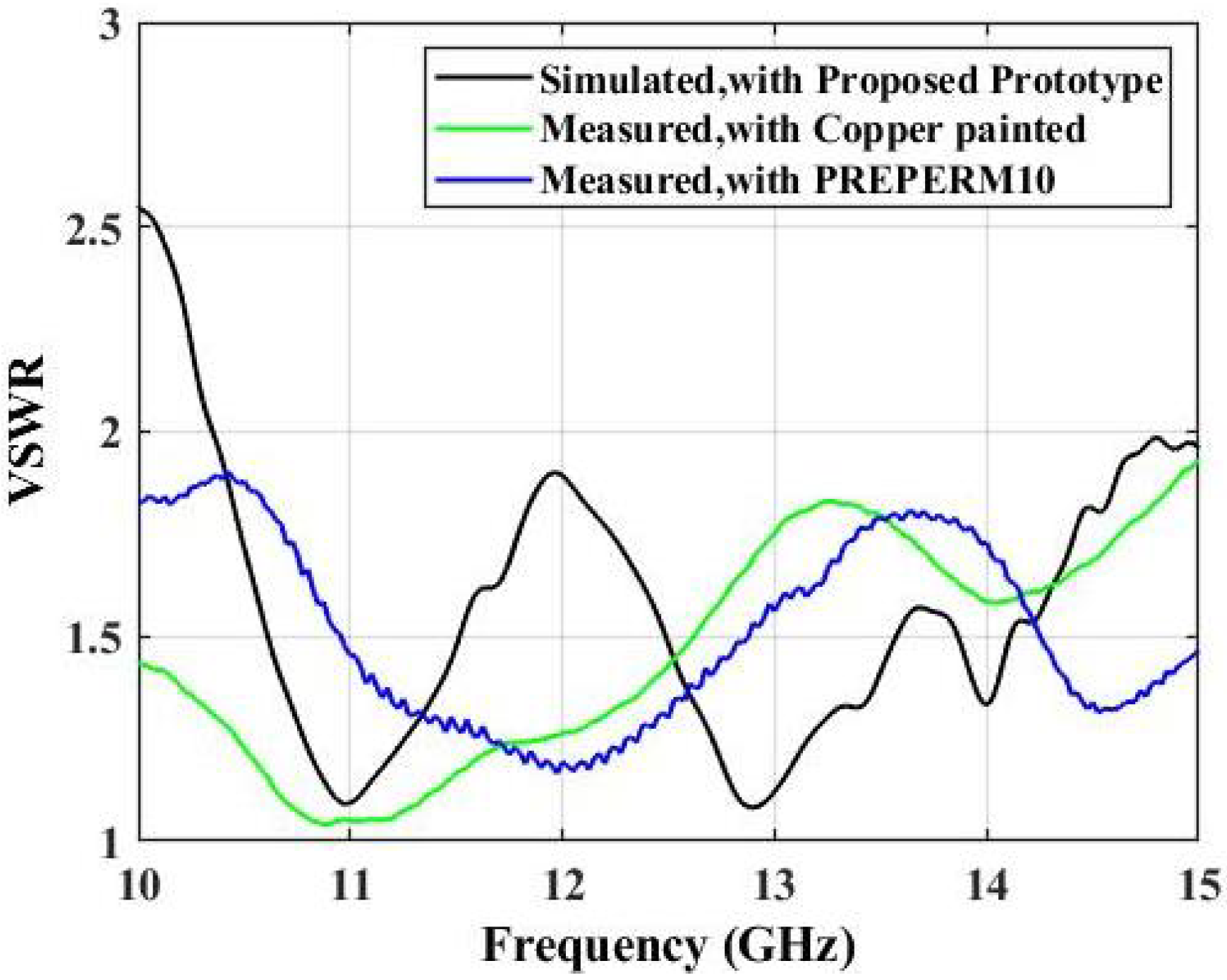
| Ref. | Operating Bandwidth (GHz) | Electrical Area (mm × mm) | Electrical Height from Feed (mm) | Lowest Operating Frequency (GHz) | Operating Frequency (GHz) | Peak Gain (dBi) | Peak Directivity (dBi) | Bandwidth (%) | 3dB Bandwidth (%) | Side Lobe Level (H-Plane) (dB) | Side Lobe Level (E-Plane) (dB) | Polarization | DBP/A | Thickness of Substrate (mm) | Aperture Size | Fabrication Technique | Weight (Grams) |
|---|---|---|---|---|---|---|---|---|---|---|---|---|---|---|---|---|---|
| [8] | 10 to 15 | 1.5 (40.5) × 1.5 (40.5) | 0.5 (13.5) | 10 | 11.1 | 18.2 | 18.7 | 30 | 21.7 | −19 in 12.6 GHz | −16.9 in 12.6 GHz | Linear and circular | n/a | 0.52 (14.05) | 1.5 × 1.5 × 0.52 | Roggers TMM3, RT/duroid 6010.5, Roggers TMM4 | n/a |
| [11] | 10 to 17.2 | 1.54 (Radius = 27 mm) | 0.5 (13.5) | 10 | 11.11 | 16.3 | 16.4 | 52.94 | 54.2 | −12 to −8 | −15 to −10 | Linear | 1501 | 0.28 (7.62) | 1.54 × 0.28 | Rogers RT 6010.2, RT6006, TMM3 | n/a |
| [13] | 10.1 to 14.9 | 3.8 (Radius = 29.25 mm) | 0.55 (14.48) | 10.1 | 11.4 | 15.75 | 16.2 | 38 | 21.5 | n/a | n/a | Linear | n/a | 0.12 (1.52) | 3.8 × 0.12 | Roggers TMM4 slab | n/a |
| [15] | Ku−band (11.7 to 19.8) | 1.75 (35) × 1.75 (35) | 0.475 (9.5) | 11.7 | 15 | 11.45 | n/a | 54 | 42.3 | n/a | n/a | Circular | n/a | 0.15 (3) | 1.75 × 1.75 × 0.15 | Period metal patches Rogers DT/duroid 5880 | n/a |
| [16] | X-band (8.88 to 11.25) | 1.98 (66) × 1.98 (66) | 0.45 (15) | 8.88 | 9 | 13.92 | n/a | 25.1 | 23.6 | n/a | n/a | n/a | n/a | 0.024 (0.787) | 1.98 × 1.98 × 0.024 | Period metal patches Rogers RT/duroid 5880 | n/a |
| [17] | 8.6 to 11.4 | 2.4 (72) × 2.4 (72) | 0.5 (15) | 8.6 | 10 | 13.8 | 16.5 | 28 | 28 | n/a | n/a | n/a | n/a | 0.026 (0.787) | 2.4 × 2.4 × 0.026 | Period metal patches Rogers RT/duroid 5880 | n/a |
| [18] | 8.2 to 12.5 | 1.5 (45) × 1.5 (45) | 0.6 (20) | 8.2 | 10 | 13 | 13.2 | 44 | 46 | n/a | n/a | Linear | n/a | 0.8 (24) | 1.5 × 1.5 × 0.8 | FR4 substrate with metal patches | n/a |
| [20] | X−band ( = 26.55 mm) | 3.85 (102) × 2.7 (72) | n/a | 10 | 11.3 | 18.7 | n/a | 38 | 9.7 | −20 in 11.3 GHz | −13.5 in 11.3 GHz | n/a | n/a | 0.45 (12) | 3.85 × 2.7 × 0.45 | Vero clear material | 195 |
| [21] | Ku−band (10.5 to 14.5) | 0.785 (Radius = 70 mm) | 0.833 (20) | 10.5 | 12.5 | 13.5 | n/a | 59 | n/a | n/a | n/a | n/a | n/a | 0.366 (50.76) | 0.785 × 0.366 | FDM | n/a |
| [22] | 5.77 to 6.24 | 12.56 (Radius = 100 mm) | 0.46 (23) | 5.77 | 6 | 17 | n/a | 7.8 | 22.2 | n/a | n/a | Linear | n/a | 0.04 (2) | 12.56 × 0.04 | Photo polymer resin with surface metalization | n/a |
| [23] | X−band ( = 28.3 mm) | 2.86 (Radius = 27 mm) | 0.96 (27.2) | 10 | 10.6 | 15 | 16.048 | 49.65 | 28.6 | n/a | −10.4 in 10.6 GHz | Linear | 699 | 0.477 (13.5) | 2.86 × 0.477 | FDM | 16.4 |
| Proposed | 10 to 15 | 2 (50) × 2 (50) | 1.17 (29.33) | 10 | 12 | 17.2 | 17.6 | 50 | 20 | −15.1 in 10 GHz, −16.9 in 12.5 GHz, −16.7 in 15 GHz | −13.7 in 10 GHz, −14.2 in 12.5 GHz, −11.5 in 15 GHz | Linear | 860 | 0.49 (12.33) | 2 × 2 × 0.49 | FDM | 79 g, copper painted, 96 g with PREPERM10 |
Publisher’s Note: MDPI stays neutral with regard to jurisdictional claims in published maps and institutional affiliations. |
© 2022 by the authors. Licensee MDPI, Basel, Switzerland. This article is an open access article distributed under the terms and conditions of the Creative Commons Attribution (CC BY) license (https://creativecommons.org/licenses/by/4.0/).
Share and Cite
Shrestha, S.; Zahra, H.; Kiyani, A.; Asadnia, M.; Abbas, S.M.; Mahmoud, A. Miniaturized Wideband Antenna Prototype Operating over the Ku-Band. Micromachines 2022, 13, 471. https://doi.org/10.3390/mi13030471
Shrestha S, Zahra H, Kiyani A, Asadnia M, Abbas SM, Mahmoud A. Miniaturized Wideband Antenna Prototype Operating over the Ku-Band. Micromachines. 2022; 13(3):471. https://doi.org/10.3390/mi13030471
Chicago/Turabian StyleShrestha, Sujan, Hijab Zahra, Arslan Kiyani, Mohsen Asadnia, Syed Muzahir Abbas, and Abdelhady Mahmoud. 2022. "Miniaturized Wideband Antenna Prototype Operating over the Ku-Band" Micromachines 13, no. 3: 471. https://doi.org/10.3390/mi13030471
APA StyleShrestha, S., Zahra, H., Kiyani, A., Asadnia, M., Abbas, S. M., & Mahmoud, A. (2022). Miniaturized Wideband Antenna Prototype Operating over the Ku-Band. Micromachines, 13(3), 471. https://doi.org/10.3390/mi13030471









